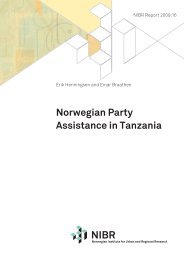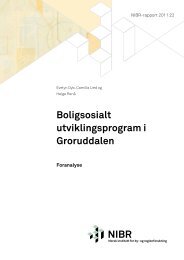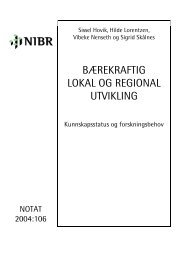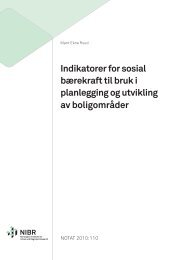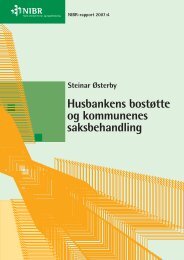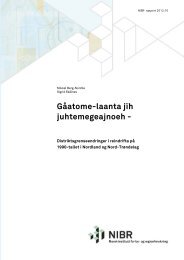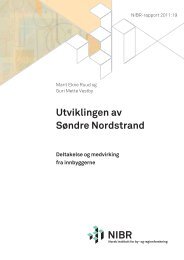International Journal of Housing Policy 19Downloaded by [Norsk Institutt for By og] at 07:07 11 March 2013Bleiklie, I. (1997). Service regimes in public welfare administration. Case studies of street-levelbureaucrats and professionals as decision makers. Oslo: Tano Aschehougs Fonteneserie.Blom, S., & Henriksen, K. (2008). Levekår blant innvandrere i Norge 2005/2006 [Living conditionsamong immigrants in Norway 2005/2006]. Report 5. Oslo: Statistics Norway.Borjas, G. J. (2002). Homeownership in the immigrant population. Journal of Urban Economics, 52,448–476.Bråmå, Å. (2006). ‘White flight’? The production and reproduction of immigrant concentration areasin Swedish cities, 1990–2000. Urban Studies, 43, 1127–1146.Bråmå, Å., & Andersson, R. (2010). Who leaves rental housing? Examining possible explanations forethnic housing segmentation in Uppsala, Sweden. Journal of Housing and the Built Environment,25, 331–352.City of Oslo. (2011). Endringer i forskrift om tildeling av kommunal bolig i Oslo kommune [Changesin the regulations for allocation of municipal dwellings in the municipality of Oslo]. Høringsbrev.Byrådsavdeling for eldre og sosiale tjenester.Clark, W. A. V. (1992). Residential preferences and residential choices in a multiethnic context.Demography, 29, 451–466.Damn, A. P. (2002). Etniske minoriteters bosætning og flytninger – de seneste 20 års økonomiskkvantitative forskningsresultater [The settlement and moves of Ethnic minorities; The quantitativeresults form the last 20 years of economic research]. AMID Working Paper Series 13/2002.Aalborg University.Ellingsen, D. (2011). Mange låner mye in Samfunsspeilet [Many citizens borrows much in the gameof society], No. 4. Oslo: Statistics Norway.Esping-Andersen, G. (1990). The three worlds of welfare capitalism. Cambridge: Polity.Finney, N. (2002). Ethnic group population change and interaction: A demographic perspective onethnic geographies. Ethnicity and integration. Understanding Population Trends and Processes, 3,27–45.Fong, E., & Chan, E. (2010). The effect of economic standing, individual preferences, and co-ethnicresources on immigrant residential clustering. International Migration Review, 44, 111–141.Fonseca, M. L., McGarrigle, J., & Esteves, A. (2010). Possibilities and limitations of <strong>com</strong>parativequantitative research on immigrant’s housing conditions. Working paper No. 06. PROMINSTAT.Institute of Geography and Spatial Planning, University of Lisbon, Portugal.Hamnett, C., & Butler, T. (2010). The changing ethnic structure of housing tenures in London,1991–2001. Urban Studies, 47(1), 55–74.Johnston, R., Forrest, J., & Poulsen, M. (2002). Are there ethnic enclaves in English cities? UrbanStudies, 39, 591–618.Juntto, A. (1992). Post-industrial housing crisis: Finland as a case study. In L. J. Lundqvist (Ed.), Policy,organization, tenure. A <strong>com</strong>parative history of housing in small welfare states. ScandinavianHousing and Planning Research, Supplement 2, 47–59.van Kempen, R. (2003). Segregation and housing conditions of immigrants in Western European cities.Eurex Lecture 7 – 13 March. Retrieved from <strong>http</strong>://<strong>www</strong>.shiva.uniurb.it/eurex/syllabus/lecture7/Lecture7-VanKempen.pdfLindberg, G., & Lindèn, A.-L. (1989). Social segmentation på det svenske bostadsmarknaden [Socialsegmentation on the Swedish housing market]. Lunds: Sociologiske Institutionen, LundsUniversitet.Lujanen M. (Ed.). (2004). Housing and housing policy in the Nordic countries. Nord2004:7. Copenhagen:Nordic Council of Ministers.Magnusson Turner, L. (2010). Study on housing and exclusion. Country report Sweden. EuropeanCommission.Medby, P., & Langsether, Å. (2007). Den kommunale utleiesektor [The municipal rented sector].NOVA Rapport 12/07. Oslo: NOVA and SINTEF Byggforsk.Molina, I. (2010). Nedslag i diskriminering på bostadsmarknaden [Signs of discrimination on thehousing market]. Unpublished report to the Equality Ombudsman (DO), Oslo.Musterd, S. (2005). Social and ethnic segregation in Europe: Levels, causes and effects. Journal ofUrban Affairs, 27, 331–348.Musterd, S., Ostendorf, W., & Breebaart, M. (1998). Multi-ethnic metropolis: Patterns and policies.Dordrecht: Kluwer.Niva, M. (1989). Bostad, politik och marknad [Housing, policy and market]. Stockholm: NordiskInstitut för Samhällsplanering.
20 H. Skifter Andersen et al.Downloaded by [Norsk Institutt for By og] at 07:07 11 March 2013Nordvik, V. (1996). Mot et mer ustabilt leiemarked [Towards a more stable rental market]. Samfunnsspeilet,4, 15–18.Normann, T. M., Rønning, E., & Nørgaard, E. (2009). Utfordringer for den nordiske velferdsstaten –sammenlignbare indikatorer [Challenges for the Nordic Welfarestate – <strong>com</strong>parable indicators].Copenhagen: Nordic Social-Statistical Committee (NOSOSKO).Quillian, L. (2002). Why is black–white residential segregation so persistent? Evidence on threetheories from migration data. Social Science Research, 31, 197–202.Rothenberg, J., Galster, G., Butler, R. V., & Pitkin, J. R. (1991). The maze of urban housing markets:Theory, evidence and policy. Chicago, IL: University Press of Chicago.Røed Larsen, E., & Sommervoll, D. E. (2011). Prisdannelsen i det norske leiemarkedet: En teoretiskog empirisk analyse av hovedmekanismer generelt og utsatte grupper spesielt [Price formationon the Norwegeian rental market: A theoretical and empirical analysis of main mechanisms andthe importance for marginalised groups]. In NOU 2011:15 Rom for alle. En sosial boligpolitikkfor framtiden. Oslo: Ministry of Local Government and Regional Development, 20 pp.Schaffer, B., & Huang, W. (1975). Distribution and the theory of access. Development and Change,6(2), 13–36.Schmidt, L. (2009). Små boliger – en kunnskapsoversikt. NIBR-report 1. Norwegian Institute forUrban and Regional Research, Oslo.Simpson, L., & Finney, N. (2009). Spatial patterns of internal migration: Evidence for ethnic groupsin Britain. Population, Space and Place, 15(1), 37–56.Skifter Andersen, H. (2008). Privat boligudlejning. Motiver, strategier og økonomi. Hørsholm: StatensByggeforskningsinstitut.Skifter Andersen, H. (2010). Spatial assimilation in Denmark. Why do immigrants move to and frommulti-ethnic neighbourhoods? Housing Studies, 25(3), 281–300.Skifter Andersen, H. (2011). Motives for tenure choice during the life cycle. Housing, Theory andSociety, 28(2), 183–207.Skifter Andersen, H. (2012). The importance of housing policies and housing markets for the housingof immigrants in the Nordic countries. Report for the NODES project. Horsholm: Danish BuildingResearch Institute at Aalborg University.Skifter Andersen, H., Andersen, H. T., & Ærø, T. (2000). Social polarisation in a segmented housingmarket. Segregation in greater Copenhagen. Geografisk Tidsskrift, 100, 71–83.Søholt, S. (2007). Gjennom nåløyet – en sammenligning av tilpasninger til boligmarkedet blanthushold av pakistansk, tamilsk og somalisk bakgrunn, Oslo 197 –2003]Through the eye of aneedle – a <strong>com</strong>parison of adaptions to the housing market among households with Pakistani,Tamil and Somali background, Oslo 1970–2003] (Unpublished master’s thesis). Oslo: Institutefor Political Science, Faculty of Social Sciences, University of Oslo.Søholt, S., & Astrup, K. (2009a). Etniske minoriteter og forskjellsbehandling i leiemarkedet [Ethnicminorities and unequal treatment in the rental market]. NIBR-report: 2. Oslo: Norwegian Institutefor Urban and Regional Research.Søholt, S., & Astrup, K. (2009b). Etterkommere av innvandrere – bolig og bostedsmønster [The secondgeneration of immigrants – housing and housing patterns]. NIBR-report: 3. Oslo: NorwegianInstitute for Urban and Regional Research.Turner, B., & Whitehead, C. (2002). Reducing housing subsidy: Swedish housing policy in aninternational context. Urban Studies, 39, 201–217.Wright, R., Ellis, M., & Parks, V. (2005). Re-placing whiteness in spatial assimilation research. Cityand Community, 5, 111–135.



